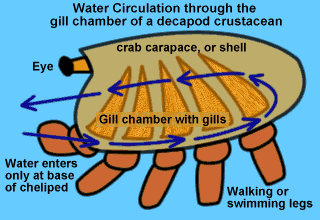|
|
Biological Factors
Oxygen and Respiration
Most sea creatures obtain their oxygen from their watery environment by using gills. The gills also release carbon dioxide out into the water as it flows over them.
Some animals, such as many bivalves, use gills to filter detritus and plankton food from the water.
However, gills can only function if they are immersed, or have access to water. How do the animals who live high on the shore for hours at a time each day respire when the water is far below them on the shore. This may occur for some individuals, such as high shore barnacles or periwinkles, for days at a time ?
They can only do so if they keep their gills moist.

Crabs have a special gill chamber that can hold water. Their gills are held by firm rods, and the filaments dangle down into the base of the chamber into a pool of water.. This system is beginning to act like a primitive lung, so that as long as the crab keeps the gill filaments moist, it can extract oxygen from the surrounding air in the gill chamber, and there is more oxygen in the air than there ever can be in water.
Many spiral-shelled molluscs can seal water inside their shell by a lid, called an operculum. Other limpet-shaped molluscs seal in water by clamping down onto the rock surface. Some molluscs use a jelly-substance to make the rim seal more effective.
References
Bennett, I. (1987) W. J. Dakin's classic study: Australian Seashores. Angus & Robertson, Sydney.
Davey, K. (1998) A Photographic Guide to Seashore Life of Australia. New Holland, Sydney.
Underwood, A. J. & Chapman, M. G. (1993) Seashores: a beachcomber's guide. New South Wales University Press, Sydney.
Biological
Factors
Oxygen & Respiration
Food and Predation
Excretion
Reproduction
Behaviour
Home
Page
Taxonomy
Biogeography
Rocky Shores
Tidal Levels
Intertidal Zonation
Environmental Factors
Biological
Factors
Feeding Relationships
Activities
Glossary
References
 Life
on Australian Seashores
Life
on Australian Seashores
by Keith Davey (C) 2000
Learning Consultant
- Media
The University of Newcastle
email at australian_seashores@hotmail.com
Scientific Consultant: Phil
Colman
site created 01.01.98 : updated 01.04.2000
